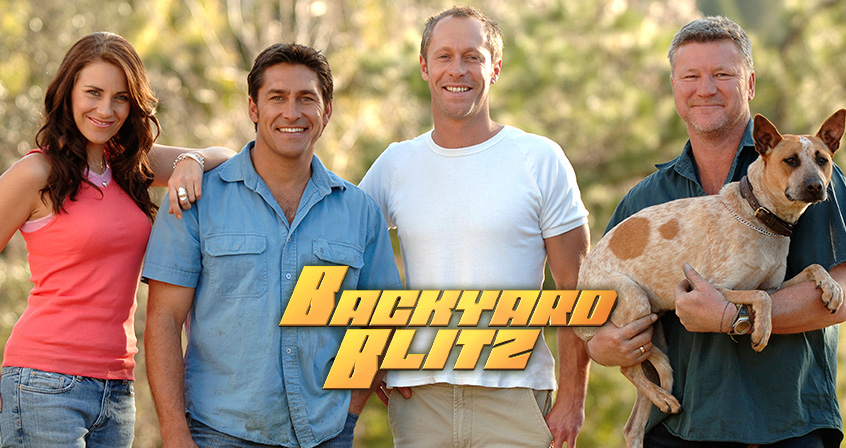Queensland’s Sunshine Coast would not be the same without people like David Dangerfield. David is a man who is thoroughly respected by his community and adored by both his students and family. His passion for the martial art of Aikido and his teaching efforts have helped many people, including youth at risk, Paralympic athletes and all those who attend his Aikido classes.
David and his wife, Wendy, have run the Aikido classes from the local community hall for many years. They made a pact with each other that if the house next door to the hall ever came up for sale they would buy it.
That was five years ago and both the hall and house have benefited from much hard work since. Unfortunately, the garden has been left till last and this is where the skills of the Backyard Blitz team have been put to use.
Design intent
Landscape designer, Greg Bell, has enhanced the oriental flavour of this tropical garden by incorporating a tea-house, granite boulders, slate stepping stones and slat screens. A meandering stepping stone path provides a journey of discovery around the garden.
Design ideas
Oriental colours, textures and shapes help to define the style and create a relaxed feel in the garden. Large dimension timbers, deep colours and structural plantings add interest and provide unity to the design.
Adapting this plan to your garden
Make a detailed scale drawing of your backyard (eg 1:100) showing the location of the house and major features, then incorporate the desired elements from our makeover. As your garden will be a different size, you will need to estimate the required amounts of materials.
Note: On your plan show the locations of any services (water pipes, sewerage, power, phone, etc) so you can avoid damaging them during the makeover.
Permits and approvals: trees in urban areas are covered by Tree Preservation Orders administered by the local council. You may need permission from the council to prune or remove a tree. A tree care professional (arborist) will be able to offer advice on this process.
Getting started
A bobcat was used to clear unwanted vegetation from the site and to excavate to sub-grade levels for Nigel’s decomposed granite courtyard and the new turfed area. Heavy materials were brought in and stockpiled beneath the carport.

Garden elements
Tea-house: Scott built a great new tea-house on the upper level of the garden, both as a focal point and a destination within the garden. White cypress pine was selected for its beautiful colour and hardiness as a structural timber. Large posts (200x200mm) were installed vertically in-ground in quick setting concrete to support the floor joists and roof beams. Joists and beams were nailed in place then bolted to the posts with galvanised cup head bolts (10x260mm). Due to the size of the timbers Scott spanned the floor width by creating a frame using joists and joist hangers. Cypress boards (140x45mm) nailed onto the joists beneath provide a rustic and solid floor to the tea-house.
Two low benches were created by bolting a joist to each post 350mm above the floor and nailing more boards across the top. A weatherproof, pitched roof was erected by nailing rafters to the top beams and to a central ridge. Prepainted fibre cement sheeting nailed to the top of the rafters with clouts created a weather-proof roof and a supporting base to rolls of Natureed connected with fence staples.

Blitz Tipz: Cypress pine is botanically classed as a softwood but has the physical characteristics of a hardwood. It is durable, hard and termite resistant making it perfect for outdoor structures.

Gateway and screen: Jody built a stylish entrance way to the garden with some help from Jamie and Scott. Two large, cypress pine posts create a gateway, with another post laid horizontally across the top and held in place with reinforcing steel rod. Treated pine posts (H4, 90x90mm) installed vertically and in line with the cypress posts support treated pine rails (H3, 90x45mm). Pre-painted pink primed battens nailed vertically in place create a partial screen to the garden and maintain the oriental theme.
Blitz Tipz: Prepainting timber work where possible makes projects like this much easier and quicker to construct.

Decomposed granite: a circular, contemplative zone has been created with an attractive combination of decomposed granite, granite boulders and slabs of slate. A sub-grade of compacted roadbase supports a decorative layer of decomposed granite spread to a depth of 70mm and compacted with a vibrating plate compactor. The large boulders were brought in with the help of the bobcat and placed into a bed of rapid setting concrete. Slabs of slate arranged in parallel bands represent a river and provide a practical component as stepping stones.
Blitz Tipz: Nigel created a slight camber to the surface of the decomposed granite to aid run-off of surface water.
Steel sculptures: Jamie introduced some art into the garden in the shape of two steel and bamboo sculptures. R12 steel reinforcing rod cut into 2 metre lengths was threaded through ply template sheets and installed vertically into a concrete footing (2000x300x300mm). Several lengths of bamboo were threaded over random rods to add some depth and a visual barrier to the screens. Spray-painted black with a rust inhibitor, the steel rods are held in place and made safe with a capping piece of treated pine.
Blitz Tipz: Steel rod will rust over time when exposed to the air as in this situation. Using galvanised rod will avoid this but it is far more expensive.
Slate stepping stones: Nigel laid a meandering pathway through the garden to create a journey and an air of mystery. The stepping stones were irregular-shaped slabs of slate set into a 4:1 sand/cement mortar bed. Each stepper was tapped level with a rubber mallet and washed off with clean water and a sponge.
Blitz Tipz: Stepping stones should be placed a comfortable pace apart from each other and be large enough to accommodate any shoe size.
Garden bed: Jody improved the already fertile soil with the addition of organic matter around new plants and by spreading cypress mulch to a depth of 75mm to reduce weed growth and to insulate the soil against moisture and temperature losses. Bromeliads have specific nutrition and drainage requirements, which were met with the addition of bromeliad mix and pine bark into the planting hole.
Blitz Tipz : Jody chose cypress mulch for its insulating properties and because the colour matched the new timber structures in the garden.
Brickwork: Nigel patched the existing brick wall to enclose the steps and make visitors to the garden travel around the stepping stone pathway. A footing comprised of common bricks and mortar provides a stable base to the new wall. Every second course had a half brick removed to enable Nigel to ‘key’ the new brickwork into the existing wall and to maximise the bond between the two walls.
Blitz Tipz: Double brick walls need to be bonded to each other with bricks that are laid perpendicular to the direction of the wall. This adds strength and prevents the two walls from separating.





